Jews And Carpets
Fact Paper 18
© Anton Felton and Samuel Kurinsky, all rights reserved
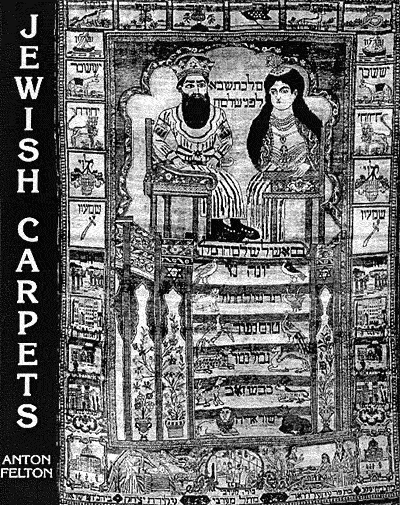
Judaic Antecedents and Carpets
"The full history of Jewish carpets is yet to be written." modestly notes Anton Felton in his comprehensive work, Jewish Carpets, and he then proceeds to write that history.1
There are limitations in our knowledge of both the history of Judaic artisanship and of the art of carpet-making. Judaic history was compromised by human agencies. The Assyrians, Babylonians, Egyptians, Greeks, and Romans, were all guilty of obliterating the record of Judaic contributions to their civilizations, as were the medieval Christians, Crusaders, and the promulgators of the Inquisition, Reformation, and Counter-Reformation. The anti-Semitic persecutions and pogroms of the modern period, the Nazi destruction of 17,000 Judaic institutions along with their archival records, and finally the burning of Judaic literature by the Nazis likewise obliterated seminal contributions of the Jews to western art, science and industry.
In the case of carpets, erosion by natural processes is largely responsible for the lack of physical evidence . "It is in the nature of carpets," notes Felton, "- variously made of silk, wool, goat hair, camel hair, cotton, linen, hemp or jute - that their life span too is limited."2
The history of both carpets and the Jews are rooted in the earliest civilization. The Jews stemmed from a civilization that first domesticated wild grains, that first used the wheel, that first passed from the age of stone and copper into the Bronze and Iron Ages. The progenitors of the Jews are depicted biblically from the outset as artists, artisans, and city-builders, and archaeologic research fully sustains that image.3
Abraham, the patriarch of the Judaic nation, was born in the area in which our earliest record of carpet-making was found. "We know from a tablet of perhaps 3000 BCE that the Sumerians had looms.4 Ur was one of their great cities and the code of Hammarubi of around 1800 BCE records its major export being wool to Babylon.5 It was from Ur, too, that Abraham set out with his family..."
"The tombs of Beni Hassan in Egypt (2800 BCE - 2600 BCE) have wall paintings of weavers at work, and there are numerous Egyptian wall paintings from 2000 BCE that depict looms."7
The Egyptian looms, however, were, at that time, primitive as compared to those of the Semitic peoples of Southwest Asia. The contrast between the highly advanced weaving and dyeing technologies of Mesopotamia and Canaan and that of Egypt is highlighted in one of the tombs at Beni Hassan the tomb of an Egyptian baron, Knumhotpe. It is dated to the 19th century BCE, perhaps about the time Abraham, awaiting the end of a drought in Canaan, settled in the Nile Delta of Egypt (Biblical Goshen). Thirty-seven Semitic trader/artisans are depicted in full scale with their wives and children on an extensive forty-foot wall of the tomb. There is no doubt as to their ethnicity, for the type of clothes, hair, and skin coloring was used by the Egyptian artists only for people from Canaan; the head of the group is named "Abushei," a distinctly Hebrew name (as, for example that of King David’s great general); and Abushei is identified in the hieroglyphic inscription as a Hyk Khase a designation commonly transcribed to "Hyksos," and meaning "chieftain from a foreign hill country." The multicolored clothes of the men, women and children are accurately depicted by the artist. They were woven on an upright loom, a weaving device as yet unknown in Egypt. They were likewise colored with dyes then unknown in Egypt.

"A whole range of novel weapons was introduced from Asia, such as the horse-drawn chariot, scale armor, the composite bow and new designs of daggers, swords and scimitars... More important than these weapons of destruction were certain abiding inventions of peace, such as improved methods of spinning and weaving, using an upright loom; new musical instruments, a lyre, the long-necked lute, the oboe and the tambourine. Hump-backed bulls were imported from an Asian source, probably brought in by ship with the greatly increased trade that the Hyksos fostered."8
Joseph’s "cloak of many colors" plays a central role in the Biblical story; it attests to the advanced state of dyeing and weaving among the Judaic progenitors. There is a dearth of physical records of this revolutionary advance in Egyptian civilization. It is due to the deliberate obliteration of virtually all physical and other references to the Semitic presence by their upper Egypt conqueror, Ahmose I and his successors. After invading the northern enclave of Egypt, they enslaved or expelled the Semites, initiating the 18th dynasty of the aptly named "Warrior Pharaohs."

The Semitic peoples continued to advance their arts and industries in Canaan. The Iron Age was born with the settlement of hundreds of villages in the hills of Canaan by the Israelites. The skills these peoples carried with them are amply elucidated in Biblical Exodus.
"Jewish carpets could not have had a more auspicious start at some time between the fifteenth and the thirteenth century BCE, than with the Divinity issuing specific and detailed instructions as to the materials and the manufacture of every part of the Tabernacle, including how the textiles were to be woven and how they were to be used to build the huge mobile tent to hold the Tablets of the Law during the Israelites wandering in the desert:"
"You should
make curtain of blue, purple and crimson yarns, and fine twisted linen;
it shall have a design of cherubim worked into it."
"You
shall make a screen for the entrance of the Tent, of blue, purple and
crimson yarns, and fine twisted linen, done in embroidery."
"The Hebrew word ‘Yeriah’ is usually (and too loosely) translated in English translated Bibles to ‘curtain’ or ‘screen.’ According to the Jewish Encyclopedia a much more correct translation would be be ‘rug’ or ‘tent cloth’, for the word applies equally to horizontally laid floor coverings, part horizontal and part vertically placed textiles, and to vertically suspended curtains."
"...They must have looked marvelous; the colors of azure, crimson, vermillion, and off-white and the weaving techniques probably similar to those used until very recently by the Bedouin of Sinai and the Negev, although more luxurious in colour and material. They were sewn together in two groups of five, which were then attached with fifty loops on either side, and, hanging on a framework, they formed the walls of the Tabernacle."9 Basically they were kelims, or flat-weave tapestries and were woven by women (Ex. 36:26) on transportable looms that stretched horizontally over the ground. The importance of these flat-weave tapestries Proverbs 31:10-27, whose memorable lines spell out the attributes of the ideal Jewish wife:"
For who can
find a good wife?
She
is more precious than Rubies.
"The verse goes on to list the very practical skills possessed by the paragon, which include the collecting and spinning of wool and flax, the making and selling of fine linens, and even the weaving of kelims, for:
...she maketh herself coverings of tapestry." 10
The involvement of Jews with purple dye production is attested to by the Talmudic assertion that among the "poor of the land" who were left behind by Nebuchadnezzar were those engaged in fishing the purple-producing snails (murex mussels) off the Canaanite coast,11 probably because the molluscs did not exist in Assyria, and the Assyrians lords wanted garments of the exotic color.
In fact, purple appears in Persia on the royal insignia of Assyria and on garments worn by Assyrian kings in the eighth century BCE, soon after the extradition from Canaan to Persia of thousands of Israelite artisans. Ezekiel (33:5,6) was well aware of the Assyrian propensity for purple, for he informed us that Oholah the harlot doted on the Assyrian "captains and rulers, all of them desirable young men, horsemen riding upon horses "who were ‘clothed in purple.’ Chapter 27 of Ezekiel goes into great detail regarding the producers and traders in the many products that flowed between East and West overseas from the Tyrian coast and overland from Damascus. Purple goods are featured prominently in several contexts and are included with other valuable export products: firs and oaks for the building of ships, benches of ivory, fine linen with embroidered work: iron, silver, tin, and lead; horses and mules; emeralds, purple [the dye?]; embroidered goods, white wool, and fine linen, coral and agate; ‘wheat of Minith’; dainties and honey; the wine of Hebron, lambs and rams and goats; spices, precious stones and gold.
Nor was Judaic knowledge of dyes limited to that derived from molluscs; another scarlet-purplish or crimson dye was produced from a red insect, the kermes, which was used to color wool. The familiarity of the Jews with the art of dye-making is underscored by such imitations of the authentic purple dyes as well as by the natural product. Samples of such artificial imitations of purple wool were recovered from the Judean Cave of Letters of the Bar-Khochba period.12
The remarkable feature of Ezekiel’s lengthy catalogue of products by which the Tyrian shippers "enriched the kings of the earth," was that purple goods were said to have come not from the Canaanite coast from which they were being shipped overseas, but from Assyria. It was "Harran, and Canneh, and Eden, the merchants of Sheba, Asshur and Chilmad" who were the "merchants in blue clothes, and embroidered work, and in chests of rich apparel"; Ezekiel also informs us that Dan and Javan attended the Tyrian fairs with ":thread, bright iron, cassia, and calmus," products that bespoke a commercial relationship with the Far East.
After being freed by Cyrus, the Persian Jews pioneered the so-called "Silk Route" to Kaifeng China. Thus, 1700 years before Marco Polo followed in their footsteps the Persian Jews brought back many products and technologies, including sericulture. The production of silk and its inclusion in textiles thereafter became featured among the arts practiced by the Jews.13
"One early carpet, dating from the eighth century BCE, may still be seen in the British Museum - albeit carved in stone on an Assyrian relief - as a precious offering to a king. The stone floors of the seventh century BCE Assyrian palaces - especially at Nineveh and today also in the British Museum - are generally accepted as carpet patterns."14
The art of glassmaking likewise surfaced in Assyria at this very time. An early glass vessel, the alabastron of Sargon II, was excavated at Nimrud (near Nineveh). This vessel is also displayed in the British Museum; it evidences another highly advanced technology borne by Israelite artisans to Assyria.15
It can be no coincidence that the "next great carpet we know of was found in the burial chamber of Cyrus the Great of Persia (559-529 BCE)." Again, the appearance of sophisticated carpet designs coincides with the transportation of many thousands of Judaic artisans by the conqueror of Judah, Nebuchadnazzer, this time to Babylonia. "Two hundred years later Alexander the Great crushed the remnants of Cyrus’ empire and, breaking into his tomb, described Cyrus’ golden funeral couch as resting on an exquisite golden carpet."16
The weaving and dyeing arts were thus practiced in Assyria and Babylonia among the tens of thousands of Israelite and Judahite slaves transported to Assyria by the conquerors of Israel and Judah, they carried on these arts as entrepreneurs after being granted freedom under Cyrus.
L. Bournois, piecing together the scraps of data concerning the Far East traffic in commodities came to the conclusion that the Jewish merchants: "were celebrated for their work in glass, byssus (linen) and silk, as well as for dyeing... From its arrival on Roman territory to its purchase by the consumer, silk passed through relatively few hands; often enough it was one family that brought the silk from the [Jewish] Persian middle-man, wove it, dyed it and re-exported it to other parts of the Mediterranean. And that family was as likely to be Jewish as it was to be Tyrian or Greek. As expert glass workers, the Jews had on hand one of the means of exchange used as payment for silk - especially the famous glass beads.17
"We do know that Jews from time immemorial have been involved in the entire cycle of the creation and marketing of carpets and were famous for their fine weaving. A Jewish weaver at the time of Herod, by the name of Baruch, must have had a peculiarly high international reputation as the Roman Governor of Spain begged Titus to send him from Israel to work in Spain.18 But perhaps the most celebrated of Jewish carpet weavers (albeit for other activities) was St. Paul."19
Felton notes that: "The Talmud records that Paul’s home town of Tarsus, in Turkey, was famous for its Tarsian carpets. The Hebrew word Tarsim originally meant a citizen of Tarsus. So famous were its products that the word came to mean a master weaver."
Clement of Alexandria (150 - c. 215 CE), a church father and important Christian philosopher, identified these Tarsian weavers in taking to task the spendthrifts who luxuriated in rich trappings. Egyptian garments made of coarse linens were not good enough for these profligates, chided Clement. "They have to deck themselves out in fabrics from the land of the Hebrews [Judah] and from Cilicia [in southern Anatolia, or Tarsia, where a colony of Jews had established itself]."20
Clement’s reference to "fabrics from the land of the Hebrews" probably referred to textiles produced in Beth Shean. The Tarsian products were rivaled only by those produced in Beth Shean, one of the Canaanite towns that had fallen to the forces of David. The Bible informs us that the weavers of fine linen of the house of Ashbea were located in that bustling city. By the third century BCE Beth Shean had already achieved fame as a producer of fine fabrics, an attribute that is reflected in several Talmudic references; the Jerusalem Talmud places great value upon the "fine linen vestments that come from Beth Shean" (Qiddushin ii, 5-62c).
Beth Shean was dubbed "Scythopolis" by the Greeks; its workshops supplied the Chinese with linens, one of the products by which the Greeks, and subsequently the Romans, redressed the balance of payments for merchandise from the East. The Judaic weavers of Beth Shean achieved world-wide recog-nition for the superiority of their woven products. The Roman Emperor Diocletian, in an attempt to curb runaway inflation, fixed prices and wages throughout the Empire in the year 301 CE by an "Edict of Maximum Prices." The value of the woven products of Beth Shean (Scythopolis) was placed at the top of the categories in which they figured: "The textile goods are divided into three qualities: First, second and third. In each group the [woven] produce of Scythopolis appears in the first class. Only the produce of Tarsus competes with it occasionally."21
The renowned Judah Ha-Nasi, for example, moved to Beth Shean, where he was joined by Rabbi Chiyya bar Abba, a scholar who is among those mentioned in the Mishnah as traveling widely in the conduct of his business Rabbi Chiyya dealt with four of the basic goods being traded from and to China: spices, products of glass, silk, and linen. Rabbi Chiyya was also a grower of flax.22 The importance of the weaving industries of Beth Shean is further attested in a Latin geographical work of the mid-fourth century, Totus Descriptus Orbis, in which Beth Shean is described as a preeminent supplier of textiles to the world.
The Jewish weaving industry was not confined to luxury goods. Not far from the metropolis of Beth Shean was the thoroughly Jewish town of Arbel, nested near the shores of Lake Tiberius. Rabbinic sources refer to the coarser textiles produced in Arbel as well as the finer wares of Beth Shean. The styles of textiles produced in Tarsus, capital of Anatolian Cilicia, were duplicated by the Judaic craftsmen of the Galilean village. The fashion became so popular that the producers, called Tarsim after the city that had given birth to it, were organized into special cooperatives, or guilds. The story is told that when the Romans arrested Rabbi Eliezer ben Partha and Rabbi Joshua ben Teradyon for ignoring the prohibition against teaching Torah, Rabbi Eliezer denied the charge, where-upon the Romans inquired why he was called Rav (master, rabbi, or teacher). "Because I am a tarsim (master of weaving)," the good rabbi retorted, undoubtedly with tongue held firmly in cheek. The story illustrates the fact that all the sages of those times worked at a trade, for they received no compensation for teaching Torah. Many were weavers.
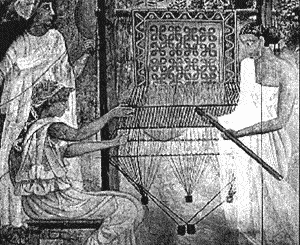
Gedaliah Alon points out that the title Rav, or master, serves in a number of Semitic languages as "the technical designation for the chief of a company of tradesmen or artisans"(Avodah Zarah, 17b). The intimacy of the Alexandrian Judaic artisans with various arts and their establishment of guild-like organizations is made explicit in a passage of the Diplostoön ("The Double Colonnade"), in which the congregation of the great synagogue of Alexandria is described: "[In the synagogue] the people do not sit at random, but rather grouped by trades: goldsmiths in their own section, silversmiths in theirs, weavers (tarsim) in theirs. So that when a newcomer entered, he sought out the members of his own craft, and on applying to that quarter, received his livelihood..."(Tosefta Sukhah 51b; and Yerushalmi Sukhah 55b).
"Josephus saw and described the screen in front of the Holy of Holies in the Second Temple. It was a Babylonian Curtain embroidered with blue and fine linen and scarlet and purple and of a texture that is truly wonderful... We see too these hanging kelims in the fresco of the synagogue of Duro-Europus where they are drawn at the sides, in the mosaics both of Beth Shean where they cover the entrance to the Temple, and of Hamat Tiberius, where they are tied together in the middle. Their purpose was to give the High Priest privacy at prayer..."23 But in 70 CE Jerusalem was conquered by Rome. The victorious general and Emperor’s son, Titus, appropriated the curtain for his palace in Rome and his legions sacked and destroyed the Temple. Three years later Masada fell. The long years of exile had begun"24
"The excavations in the 1960s at Masada uncov-ered fragments of a rare two-sided wool rug with knotted cut pile in red, blue and yellow.25 Similarly, excavations at the Cave of Letters (132 BCE to 35 CE) in Israel brought to light numerous linens and a white wool tent yarn."26
"But the loss of statehood did not put an end to Jewish involvement in carpets, weaving and dyeing. A Jewish testator of the first century left a bequest to the Union of Carpet Weavers and Purple Dyers in Hieropolis in Phrygia to decorate his tomb on Passover and Shavuot."27
"In the fourth century, curtains embroidered with fantastic figures were actually called ‘Jewish Curtains.’ It is known too, that the major skills of Jews in Italy in the height of the Roman Empire from 100 to 300 CE were weaving and garment making, acting, banking, and shipping. The near absence of rain in Egypt has preserved many a text and textile, telling us of the enduring importance of Jews in the production and distribution of textiles in the centuries of Roman rule before the Islamic conquest as well as in the centuries that followed."28
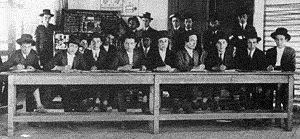
"The Babylonian Talmud was written between the third and the fifth centuries CE. Inevitably, the great rabbis directed their intellectual ingenuity to the question of whether a carpet was in religious terms clean or unclean. Different questions arose. Both flax and wool had been available in the Promised Land prior to Joshua’s conquest, and the prohibition against any mixing of these two materials excluded carpets, since the prohibition was generally limited to items of clothing. The rabbis questioned the Halakhic status of a ‘a sheet,’ a matting underlay or a mat when made into ‘tents." For rugs might form a passage for uncleanlyness and [also] a screen [against it]; [for] [some] a screen but not a passage; [and some] form neither a passage nor a screen.’29 Among the elements discussed were the material property of the mat: its weft, knots loops, fringes, and completeness."
"Another Talmudic response, that of the First century CE Babylonian scholar Rav Huna, brings us close to Jewish artesans of the Sasanid Empire. All the major crafts were separated into guilds, each guild having its own work songs. Initially, the Rav’s pronouncement is mystifying. ‘The songs of the boat-haulers and that of the ploughmen are permitted, but those of the weavers are forbidden.’"30
Felton adds: "I do just wonder if these songs were not chanted instructions of the master-weaver to his apprentices of the colour of each knot, in sequence. This incredible feat of memory - a carpet can have 250,000 - 2,000,000 separate knots - enabled certain classical carpets to be produced with maximum efficiency. And could it be that the chants of the boat haulers and the ploughmen, both activities being constantly on the move, caused little or no offense to anyone, whereas the weavers’ more settled neighbors would have no choice but to hear their chanting, day in and day out, six days a week?"
"At the end of the seventh century CE Islam had conquered the Middle East... The reports of Jews engaging in weaving and dyeing wool and trading in carpets increase throughout the medieval period. In tenth century Islamic Spain, two Jews, Jacob and Joseph Ib Gan, were famous for the silks and banners that they had woven for Caliph Hisham."31
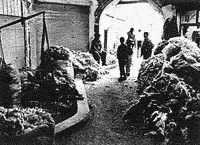
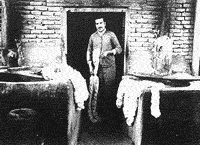
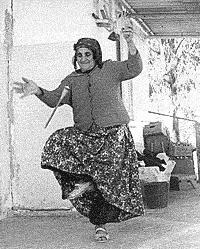
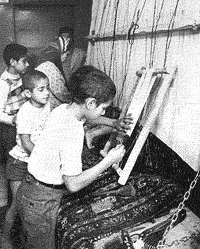
"The Genizah - a semi-secret attic - in the synagogue in old Cairo safeguarded a vast treasure trove of letters and documents dating as far back as the eighth century CE. The information revealed about the Jewish involvement in carpets from the tenth to the thirteenth centuries CE is overwhelming.32 We hear the complaint of a weaver who had been forced to work in the royal factory in Damascus that, ‘The artesans of this profession are Jews but I am the only Karaite among them.33 The ketuba of a poor bride, who had been married in Tyre in the Lebanon in 1054 CE, reveals that she had but one pile carpet that also had to serve as her bed. We find references to wall-to-wall carpeting as well as to the classic placements of carpets - one large central rug framed by two long runners either side and a smaller ‘door mat’ to the front. In a letter sent from Aden to India (how it ended up in Cairo is a mystery) we read of another pile carpet as having the signs of the Zodiac woven into it. Abraham ben Yiju writing in the 1140s from Mangalore, a port on the south coast of India, sends away for his mats to the horn of Africa and buys at least one velvet-like carpet made in Gukarat.34 We read, too, of complaints against wives who stole their husbands carpets and of wives who pawned their family carpets. A court order of 3 September, 1159 CE determines a partnership dispute over a carpet factory and a later document refers to ‘a carpet house’ in old Cairo. We glean from another letter that the Gaon (head) of the Jewish Academy of Baghdad had actually been a weaver. And of doctors, such as Maimonides, (who also taught at the old synagogue) who had to have extra large carpets woven for their waiting rooms to seat the crowds of patients. It was Maimonides who, in 1176 -77 CE attested to the pride of the synagogues in Muslim Spain, North Africa, and Palestine in their fine carpets."
"An eleventh century record in the Geniza highlights the importance of carpets in its account of the conflict between two synagogues in old Cairo. One synagogue, the Palestinian, had its Jewish roots in the Jewish community of Byzantium, the other in the community of the Eastern Caliphate in Iraq. With startling contemporary resonance, both solicit the members of the other. The synagogue of the Caliphate offers various titles and honours. The enticements of the Palestine synagogues, however - in addition to the promise of shorter services - include its precious Bible codices, its magnificent Torah scrolls, and its beautiful carpets on which the congregation would sit."
"By 1147 CE, the Normans had completed their conquest of Sicily and their king, Roger II, was busy building up an empire. In a lightning raid on Thebes in Greece, his marines captured a batch of Jewish weavers to strengthen the skills of the royal factories in Palermo.35 Some twenty years later Rabbi Benjamin ben Jonah of Tudela (the greatest of the Jewish explorers of the Middle ages) visited Thebes, reporting that there were 2000 Jews living there, and that, "They are the most skilled artificers of silk and purple cloth throughout Greece."36
"Benjamin also visited the Jewish communities in the South of Italy and in his report on their commercial activities drew special attention to their skills in weaving and dyeing. We also know from him that by the end of the twelfth century there were substantial Jewish communities in most of the major carpet producing areas of Iran. He estimated the Jewish population of Hamada at 30,000, of Isfahan to be at 15,000, and Shiraz at 10,000. Another contemporary report states that the 15,000 strong Jewish community of Tustar (Sushtar) actually controlled the carpet trade of that region. Two hundred years earlier, a Muslim geographer reported that ‘all the land from Isfahan to Tustar (Sushtar) was settled by Jews in such numbers that the whole area was called Yahudistan."37
"...In Italy, in Ferrara at the Court of the Duke Alfonso I d’Este, the master weaver Saladino (a common Jewish name) produced wonderful carpets for his patron. Saladino had been born in Cairo and moved to Ferrara in 1490 CE where he employed many weavers in a large carpet workshop. It has been suggested that the magnificent carpet bequeathed by Alphonsi I in his Will of 23 August 1533 CE to Bona, Queen of Poland, was one of Saladinos."38
"It is Spain that produces the oldest surviving Jewish carpet. Dated not later than the early fourteenth century (and perhaps much earlier) it is preserved in the Islamic Museum in Berlin... It depicts the Ark of the Covenant in a repetitive design."39 At the end of the fourteenth century there were numerous Jewish weavers in Barcelona.. And explicit legal documents of 1406 CE refer to ‘the Jewish weavers of Zaragosa.’40 By the end of the fifteenth century there were Jewish weavers to be found in almost every small community.41 and in the Catalayid district the weavers even worshiped in their own separate synagogue."42
"[After the Spanish Edict of Expulsion of 1492] many Jewish merchants, dyers and weavers were welcomed for their skills in the expanding Ottoman Empire. By 1535 CE in two suburbs of Constantinople alone there were 8000 Ladino-speaking Jewish households.43 Ita Aber, the U.S. textile historian, reports that ‘ Throughout Europe and the Middle East, the fine quality carpets and brocaded textiles that begin to appear during this period, are believed to have been an important contribution of those expelled people.’ She goes on to cite the dramatic change in the style of Spanish rugs and concludes, "It follows that the improved quality of rugs and other crafts in Europe and Africa was doubtless a direct result of the migration of these people." The Jewish refugees soon established major carpet weaving centres in the Ottoman Empire, perhaps the most important being that in Salonica. By the seventeenth century Mustafa be Abdalla Hadshi Halfa wrote of the Jewish weavers that ‘they produce the world-famous multi-coloured carpets which nowhere are made so well,’ and one hundred years later a French scholar visiting Macedonia reported. ‘The Salonican Jews produce carpets of all sizes and ranging in quality from the best to the ordinary.’44 We even know of some who fled to Palestine and established new textile and dye works in Nablus and Safed... And in Rome the Pope himself granted a patent for an improved method of manufacturing silk to an Italian Jew, Meir Magino.45
[In Iran] the great Shah Abbas I (1587-1629 CE), himself an able weaver, brought many Jews to his new capitol of Isfahan for their high skill in dyeing... many of them were members of the all-powerful weaving guilds. There they joined the original Jewish community in the northern sector Yehudiyya, so called because it was said to have been founded and settled by Jewish captives of Nebuchadnezzar in the sixth century BCE."46
The most notable effect of the dispersion of the Jews was the appearance of a host of sophisticated disciplines coincident with the establishment of Judaic communities throughout the Diaspora. They were doctors and accountants, miners and smiths, local tradesmen and entrepreneurs who traveled far-flung roads and international seas. Not least among the arts and industries they brought with them and practiced in all the lands in which they resided were those connected with the weaving and dyeing of fibers, textiles, coverings and carpets.
"No summary of the Jewish involvement in carpets would be complete without reference to the Jews of Kurdistan, a vast region south of the Caucasus covering parts of Turkey, Iraq, Iran, and Syria. They were descended partly from the Israelite tribes who had been deported there by the conquering Assyrians after 722 BCE and partly from converts following Queen Helena of Adiabene’s conversion to Judaism in 30 CE. Throughout much of that long sojourn in Kurdistan it is clear from the folk tales and traveler’s reports that they were accomplished weavers."
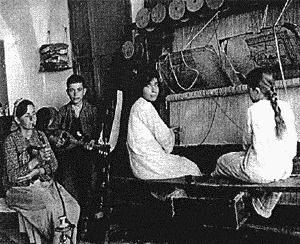
Manual labor was universally considered odious and demeaning by conquering peoples. The Jews, far from decrying engagement in physical labor, esteemed creative vocations, whether physical, mental, or spiritual. The admonishment recited repeatedly in every Jewish household and in every synagogue, "Forget not that we were once slaves in Egypt," served through the centuries as an enduring reminder of the dignity of labor and as a rebuke to those who would set himself above the "common" laborer. The sages proclaimed that "work is a great, strong foundation of Torah, a precondition to the study of Torah, and of greater value than God-fearing."
The Tannaim (scholars of the Mishnah) and the Amoraim (scholars of the Talmud), practiced what they preached; they labored proudly at trades to earn their daily sustenance. Teaching Torah was not considered an activity for which compensation was required but a privilege for which remuneration was unnecessary. "Torah is not a spade" was the precept practiced by the sages as they eked out a living by creative labor.
"God, after all," it was argued, "was the ultimate artisan. It was through his labor that the world was created. He earned a rest on the Sabbath, setting an example for all mankind."
Notes
- Anton Felton,
Jewish Carpets, published in England in 1997 by the Antique Collector’s
Club. The book is availabme from the Hebrew History Federation Ltd.
Note: All un-footnoted quotes are from Felton’s book . Page nos. of the quotations from Felton’s book are recorded at the end of the last consecutive paragraph - Felton, 18.
- Gen. 4:17-19 .artists: Jubal; artisans:Tubal; city-builder: Cain. For a fuller explication of the subject see: Samuel Kurinsky, Fact Paper no. 14, Nomads? No!. Hebrew History Federation Ltd., 1. Samuel Kurinsky, The Eighth Day; The Jewish Contribution to Civilization, Jason Aronson, 1994, 1-10.
- [Felton]: H. Ling Roth, Studies in Primitive Looms: Ruth Beann, Bedford, 1977, 147.
- [Felton]: J. Harris, 3000 Years of Textiles, British Museum Press, 1993, 54.
- Felton, 17.
- Roth, Ibid, Felton also quotes from S. Kurinsky, Hebrew Federation Newsletter No. 61, 1996, 6, and notes that we can get a sense of the vast scale of the wool trade in Ur from an ancient Akkadian tablet that indicates that nearly 9000 slaves were employed in the wool industry, Jack Finegan, Light from the ancient Past, Vol. I, 1946, reprint, Princeton, N.J. Princeton University Press, 1074, 52\
- Cyril Aldred, The Egyptians, Thames and Hudson, 1961, 139.
- Felton notes (p. 172) that ‘each thread of the tapestry of the Tabernacle was incredibly thick twenty-four ply, being made up of four strands of the four different colours folded six times.’"(Rashi to Exodus 26:1)
- Felton, 18-20.
- Israel Herzog, "Proceedings of the Belfast Natural History and Philosophical Society, Appendix B, " in The Royal Purple and the Biblical Blue, ed. Moshe Ron and Ehud Spaniel, Keter Jerusalem, 1987, 144
- Yigael Yadin, The Finds from the Bar-Khochba Period in the Cave of Letters, Israel Exploration Society, Jerusalem, 1963, 182-187.
- Samuel Kurinsky, The Glassmakers, chapter 8: The Linen, Glass, Spice and Silk Route," 251-295.
- Felton , 18: L. Allane, Oriental Rugs: A Buyers Guide, Thames and Hudson, London, 1988.
- Samuel Kurinsky, The Eighth Day, 235.
- Felton, 18.
- L. Bournois, The Silk Road, Dutton, New York, 1966, 88,89.
- L. Freehof and B. King, Fabrics of Synagogues and Home, Heartside press, New York 1966, 19.
- Felton 20, 21: C. G. Jung, Man and his symbols, Aldous books, 1964, 89.
- Gedaliah Alon, The Jews in Their Land Harvard Un. Press, Cambridge, 1989, 169; Samuel Kurinsky, The Eighth Day, 256.
- Avi Yonah, "Scythopolis," Israel Exploration Journal, 12:2 1962, 128-189.
- Samuel Kurinsky, The Eighth Day, 255.
- Felton: 173.
- Felton: 21
- Felton: Hero Granger Taylor, ‘Legacy of Masada’ Hali, 82, 1995.
- Felton: 173
- Felton: J. Harris, 5000 Years of Textiles, British Museum Press, 1993, 60.
- Felton: Joy Ungerleider-Mayesson, Jewish Folk Art, Summit Books, New York, 1986, 38.
- Felton: Dr. I. Epstein,. Oholoth, 8:1 The Babylonian Talmud, Seder Tohoroth, The Soncino Press, London, 1948, 179.
- Felton: The Talmud, Sotah 48a, cited in M. Wischnitzer, A History of Jewish Crafts and Guilds, Jonathan David, 1945, 47.
- Felton: Franz Lansberger, Development of Jewish Art, Union of American Jewish Congregations, Cincinatti, 1944.
- [Felton]: Much of the information from the Geniza comes from S.D. Goitein, A Mediterranean Society, n. of California Press, Berkeley, 1991.
- Felton: S. D. Goitein, ‘Petitions to Fatimid Caliphs from the Cairo Geniza,’ Jewish Quarterly Review, (1954) XLV, 30-38.
- Felton: A Gosh In an Antique Land, Granta 1992, 13 and 269, quoting from the Geniza documents in the University Library, Cambridge, T-S K 25 252 and T-S 18J2 fol.7.
- Felton: John Julius Norwich, The Kingdom in the Sun, Longmans, 1970, 131.
- Felton: Ekan Adler, e. Travelers I the Middle Ages Dover, New York, 1987, 53.
- Felton: Josephine Bacon, The Illustrated Atlas of Jewish Civilization, Andre Deutsch, London, 1969, 31 and 35. And Lawrence D. Loe, Outcast: Jewish Life in Southern Iran, Gorden and Breach Science Publishers Inc., New York, 1977, 280.
- Felton notes: "I am indebted in this - and in much else - to Alberto Boralevi, Oriental Carpets and Textile Studies II [London, 1986].
- Felton: Kurt Erdmann, Seven Hundred Years of Oriental Carpets, Faber and Faber, 1970, 143, fig. 18
- Felton: I. F. Baer, A History of the Jews in Christian Spain, Am Oved, Israel, 1959, 105.
- Yom-Tov Assis, "Synagogues in Medieval Spain."
- Felton: Wischnitzer, ibid., 111.
- E. Gill, review of P. Mantell, "Constantinople, City of the World’s Desire," Hali, 85 (March 1996), 113
- Wishnitzer, ibid., 111
- Cecil Roth, The Duke of Naxos, Jewish Publishing Society, 1945, 117.
- Felton, 25.
